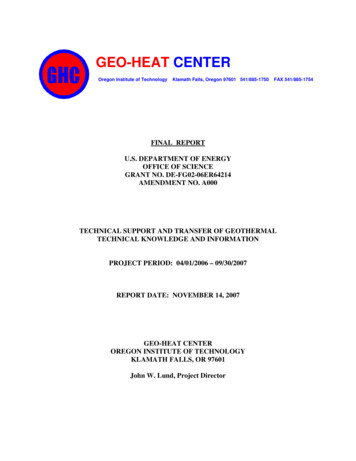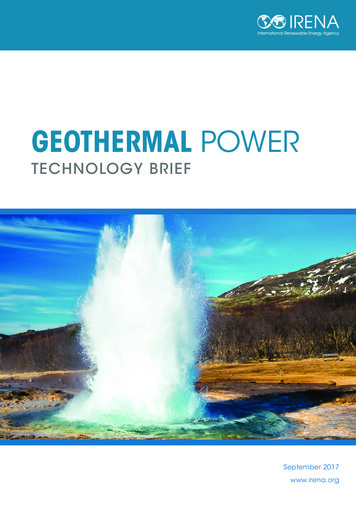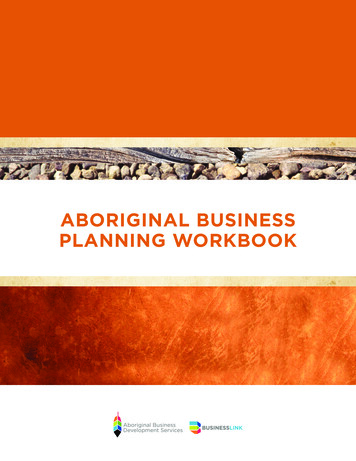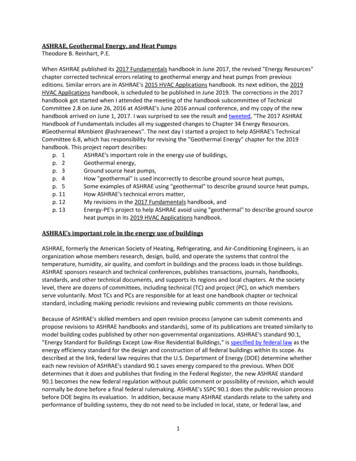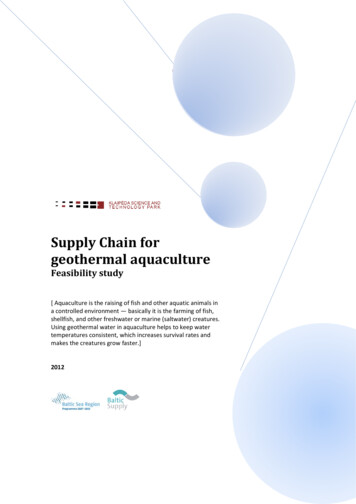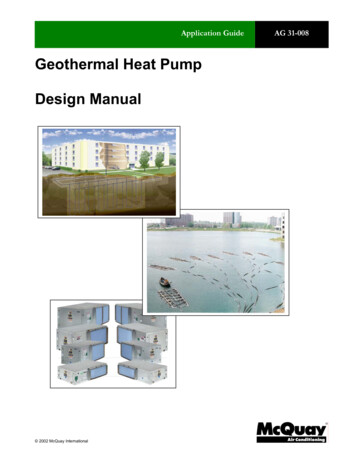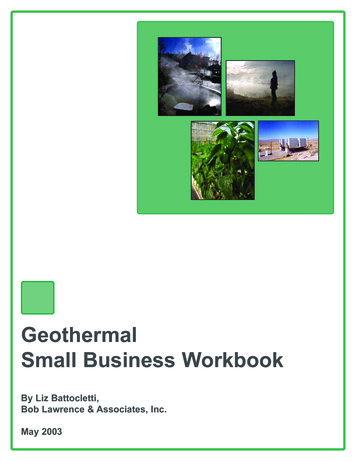
Transcription
GeothermalSmall Business WorkbookBy Liz Battocletti,Bob Lawrence & Associates, Inc.May 2003
GeothermalSmall Business WorkbookBy Liz Battocletti,Bob Lawrence & Associates, Inc.May 2003Produced for the U.S. Department of Energy, Office of Energy Efficiency and Renewable Energy,Geothermal Technologies Program under Contract No. DE-FG03-01SF22365
DisclaimerThis information was prepared as an account of work sponsored by an agency ofthe U.S. Government. Neither the U.S. Government nor any agency thereof, norany of their employees, makes any warranty, express or implied, or assumes anylegal liability or responsibility for the accuracy, completeness, or usefulness of anyinformation, apparatus, product, or process disclosed, or represents that its usewould not infringe privately owned rights. Reference herein to any specificcommercial product, process, or service by trade name, trademark, manufacturer,or otherwise, does not necessarily constitute or imply its endorsement,recommendation, or favoring by the U.S. Government or any agency thereof. Theviews and opinions of authors expressed herein do not necessarily state or reflectthose of the U.S. Government or any agency thereof.
Geothermal Small Business WorkbookTable of ContentsINTRODUCTION . . . . . . . . . . . . . . . . . . . . . . . . . . . . . . . . . . . . . . . . . . . . . . . . . . 1GEOTHERMAL PROJECTS . . . . . . . . . . . . . . . . . . . . . . . . . . . . . . . . . . . . . . . . . 4Aquaculture . . . . . . . . . . . . . . . . . . . . . . . . . . . . . . . . . . . . . . . . . . . . . . . . . . 6Greenhouses . . . . . . . . . . . . . . . . . . . . . . . . . . . . . . . . . . . . . . . . . . . . . . . . 15Industrial or Agricultural Processes . . . . . . . . . . . . . . . . . . . . . . . . . . . . . . 23Resorts and Spas . . . . . . . . . . . . . . . . . . . . . . . . . . . . . . . . . . . . . . . . . . . . . 26Space and District Heating . . . . . . . . . . . . . . . . . . . . . . . . . . . . . . . . . . . . . 29Small-scale Power Generation . . . . . . . . . . . . . . . . . . . . . . . . . . . . . . . . . . 37Hot Contacts . . . . . . . . . . . . . . . . . . . . . . . . . . . . . . . . . . . . . . . . . . . . . . . . 43Regulatory and Environmental Issues . . . . . . . . . . . . . . . . . . . . . . . . . . . . . 45THE BUSINESS & FINANCING PLAN . . . . . . . . . . . . . . . . . . . . . . . . . . . . . . .Business Description: Who and why are you? . . . . . . . . . . . . . . . . . . . . . .Product or Service: What do you do? . . . . . . . . . . . . . . . . . . . . . . . . . . . . .Marketing Plan: Market Cubed . . . . . . . . . . . . . . . . . . . . . . . . . . . . . . . . . .The People: Management & Personnel . . . . . . . . . . . . . . . . . . . . . . . . . . .Show Me the Money . . . . . . . . . . . . . . . . . . . . . . . . . . . . . . . . . . . . . . . . . .485156698692OUTLINE OF A BUSINESS PLAN . . . . . . . . . . . . . . . . . . . . . . . . . . . . . . . . . . 108FINANCIAL PROPOSAL . . . . . . . . . . . . . . . . . . . . . . . . . . . . . . . . . . . . . . . . . 110CONCLUSION . . . . . . . . . . . . . . . . . . . . . . . . . . . . . . . . . . . . . . . . . . . . . . . . . . 113GLOSSARY . . . . . . . . . . . . . . . . . . . . . . . . . . . . . . . . . . . . . . . . . . . . . . . . . . . . 114REFERENCES . . . . . . . . . . . . . . . . . . . . . . . . . . . . . . . . . . . . . . . . . . . . . . . . . . 122APPENDIX:Regulatory Information for the Federal Government and Selected States . . . . . 124
Introduction“To accomplish great things, we must not only act, but also dream; not only plan, butalso believe.”— Anatole FranceSmall businesses1 are the cornerstone of the American economy. Over 22 millionsmall businesses account for approximately 99% of employers, employ about halfof the private sector workforce, and are responsible for about two-thirds of net newjobs.2 Many small businesses fared better than the Fortune 500 in 2001. Non-farmproprietors’ income rose 2.4% in 2001 while corporate profits declined 7.2%.Yet not all is rosy for small businesses, particularly new ones. One-third closewithin two years of opening. From 1989 to 1992, almost half closed within fouryears; only 39.5% were still open after six years.3 Why do some new businessesthrive and some fail? What helps a new business succeed? Industry knowledge,business and financial planning, and good management. Small geothermalbusinesses are no different.Low- and medium-temperature geothermal resources exist throughout the westernUnited States, the majority not yet tapped. A recent survey of ten western statesidentified more than 9,000 thermal wells and springs, over 900 low- tomoderate-temperature geothermal resource areas, and hundreds of direct-use sites.4Many opportunities exist for geothermal entrepreneurs to develop many of thesesites into thriving small businesses.1A small business is defined as a business with less than 500 employees.2“Small Business Indicators for 2001,” Small Business Administration, http://sba.gov/advo/stats/#general .3“Small Business by the Numbers,” Small Business Administration, Office of Advocacy, http://sba.gov/advo/stats/#general .4Geo-Heat Center, http://geoheat.oit.edu/ . The database includes 404 western-U.S. communitieswith a combined population of 9.2 million that could potentially utilize geothermal energy fordistrict heating and other applications. Of the total 2,479 thermal wells that were identified ashaving temperatures greater than or equal to 50ºC (122ºF), 1,722 are located within five miles of acommunity. If these collocated resources were used only to heat buildings, the cities have thepotential to displace 50 million barrels of oil per year.Geothermal Small Business Workbook1
The Geothermal Small Business Workbook (“Workbook”) was written to givegeothermal entrepreneurs, small businesses, and developers the tools they need tounderstand geothermal applications—both direct use and small-scale powergeneration—and to write a business and financing plan.The Workbook will:!Provide background, market, and regulatory data for direct use andsmall-scale ( 1 megawatt) power generation geothermal projects;!Refer you to several sources of useful information including ownersof existing geothermal businesses, trade associations, and otherorganizations;!Break down the complicated and sometimes tedious process of writinga business plan into five easy steps;!Lead you—the geothermal entrepreneur, small company, or projectdeveloper—step-by-step through the process needed to structure abusiness and financing plan for a small geothermal project; and!Help you develop a financing plan that can be adapted and taken topotential financing sources.The Workbook will not:!Substitute for financial advice;!Overcome the high exploration, development, and financing costsassociated with smaller geothermal projects;5!Remedy the lack of financing for the exploration stage of ageothermal project; orSolve financing problems that are not related to the economicsoundness of your project or are caused by things outside of yourcontrol.!52“Unfortunately for smaller and medium sized projects, development costs are not proportionate tothe size for the project.Legal costs in particular are not linearly related to project size.” DraftFinancing Readiness: A Handbook for Energy Project Developers, for the California EnergyCommission by Power Project Financing, Inc., December 11, 1997, pp 4-1 and 4-2.Geothermal Small Business Workbook
Supported by the U.S. Department of Energy (DOE), Office of Energy Efficiencyand Renewable Energy, Geothermal Technologies Program under Contract No.DE-FG03-01SF22365, the Geothermal Small Business Workbook is the first oftwo. The second workbook will describe various types of financing sources forgeothermal entrepreneurs, small companies, and developers, and explain theirfinancing criteria. It is expected to be available at the end of 2003.Special appreciation for their help goes to Allan Jelacic, Roy Mink, and SusanNorwood of DOE’s Geothermal Technologies Program; Toni Boyd, John Lund,and Kevin Rafferty of the Geo-Heat Center at the Oregon Institute of Technology(OIT); Jamie Albert of OIT’s Small Business Development Center; MarilynNemzer of the Geothermal Education Office; and Roger Hill of Sandia NationalLaboratories. The author would also like to thank the businesses which respondedto the Small Geothermal Business Survey and agreed to be listed as contacts in theWorkbook.All photographs unless otherwise noted come from the National Renewable EnergyLaboratory Photographic Information eXchange collection.6 Cover photographs ofgeothermal sites are clockwise from left to right, Pagosa Springs in Colorado, afish farm in Colorado, the Wineagle plant in California, and Valley FreshGreenhouse in Colorado.The Geothermal Small Business Workbook waswritten under the aegis of GeoPowering theWest (GPW).7 GPW is a DOE-sponsoredactivity to dramatically increase the use ofgeothermal energy in the 19 western UnitedStates.86National Renewable Energy Laboratory Photographic Information eXchange (PIX), http://www.nrel.gov/data/pix/ .7See the GeoPowering the West website, owering.html .8The 19 western states targeted by GPW are Alaska, Arizona, California, Colorado, Hawaii, Idaho,Kansas, Montana, Nebraska, Nevada, New Mexico, North Dakota, Oklahoma, Oregon, SouthDakota, Texas, Utah, Washington, and Wyoming.Geothermal Small Business Workbook3
Geothermal Projects“The price of success is hard work, dedication to the job at hand, and thedetermination that whether we win or lose, we have applied the best of ourselves tothe task at hand.”— Vince LombardiGeothermal energy is heat (thermal) derived from the earth (geo). It is the thermalenergy contained in the rock and fluid in the earth’s crust. Geothermal resourcescome in all shapes, sizes, locations, and temperatures. A geothermal resource’stemperature usually determines how it is used.POTENTIAL USERESOURCETEMPERATUREGround-source heat pumpsDirect useElectricity generation4ºC to 38ºC / 40ºF to 100ºF38ºC to 150ºC / 100ºF to 302ºF 150ºC / 302ºFHighest temperature geothermal resources are generally used only for electricpower generation. Current U.S. geothermal electric power generation totalsapproximately 2,800 MWe, equivalent to about four large nuclear power plants.Geothermal power plants range in size from a 350-kWe unit at the Wineagle plantto the proposed 187-MWe Salton Sea Unit 6 plant.Lowest temperature geothermal resources are harnessed by ground-source heatpumps. Heat pumps transfer heat from the soil to the house in winter and from thehouse to the soil in summer.994For more information on geothermal heat pumps, see the GeoExchange Geothermal Heat PumpConsortium website: http://www.ghpc.org/home.htm , and “An Information Survival Kit for theProspective Geothermal Heat Pump Owner,” by Kevin Rafferty, Geo-Heat Center,Geothermal Small Business Workbook
Direct use projects have temperatures between those of heat pumps and electricpower generation. They use heat in the water directly for a variety of purposesincluding to grow flowers, raise fish, heat buildings, or dry vegetables. The currentU.S. installed capacity of direct use systems totals 600 MWt, enough to heat115,000 average-sized houses.Geothermal projects can be “cascaded,” e.g., use the same geothermal resource formultiple purposes, thereby increasing the operation’s economics. Empire Foods inNevada uses geothermal resources to generate electricity and dehydrate 26 millionpounds of dried onion and garlic annually. Many spas and resorts use geothermalresources for heat, hot water, and pools, not necessarily in that order. And LiskeyFarms in Oregon has used its geothermal resource to grow bedding plants andperennials, heat buildings and greenhouses, wash equipment, mix with choppedhay to feed calves, raise tropical fish, and water cattle.There are five basic types of direct use geothermal ial and agricultural processes,Resorts and spas, andSpace and district heating.Direct-use systems are typically composed of three components:1.A production facility – usually a well, to bring the hot water tothe surface;2.A mechanical system – piping, heat exchanger, controls, todeliver the heat to the space or process; and3.A disposal system – injection well or storage pond, to receivethe cooled geothermal fluid.10The following section gives a brief description of each type of direct use project, aswell as small-scale ( 1 MWe) geothermal power plants, and provides market datahttp://geoheat.oit.edu/ghp/ghptable.htm .10U.S. Department of Energy Geothermal Energy Program, “Direct Use of Geothermal Resources,” .html .Geothermal Small Business Workbook5
when available.11 It ends with a list of useful contacts and a brief discussion ofrelevant regulatory and environmental issues.AquacultureAquaculture is “the production and sale of farmraised aquatic plants and animals.”12 Geothermalaquaculture uses naturally occurring warm waterto accelerate the growth of fish, shellfish, reptiles,amphibians, and aquatic plants. Rearing fish incontrolled temperatures can boost growth rates by50 to 100%, dramatically increasing the numberof harvests possible each year. Aquaculture is ahigh potential development area forlow-temperature geothermal resources.13Tilapia fish farm, ColoradoAqua-farmers in the United States growalligators, bass, catfish, giant fresh water prawns,gold fish, koi, lobster, snails, sturgeon, tilapia, tropical fish, trout, turtles, and waterlilies. There are currently 48 geothermal aquaculture operations in 11 Westernstates.146STATENUMBER a16Colorado4Idaho811Market analysis statistics are provided by Zapdata.com Industry Reports, 2002, http://www.zapdata.com .12Aquaculture Information Package, ed. Tonya Boyd and Kevin Rafferty (Klamath Falls, OR: GeoHeat Center, 1998), p. 6.1. To obtain in PDF format, see http://geoheat.oit.edu/pdf/aqua.pdf .13Paul Lienau, “Geothermal Aquaculture Development Introduction,” Geo-Heat Center, http://geoheat.oit.edu/public/bulletin/bci24.htm .14“Aquaculture Direct Use Sites,” Geo-Heat Center, http://geoheat.oit.edu/directuse/aqua.htm .Geothermal Small Business Workbook
STATENUMBER w Mexico2Oregon2South Dakota1Utah4Wyoming1TOTAL48Fish and other species can be raised in simple open air earthen ponds orsophisticated fiberglass tanks. In addition to the materials used, the cost of ageothermal aquaculture project depends on the size of the project, the speciesraised, and whether a well already exists. Well depths and drilling costs varywidely from 30- 200 per foot; most common well drilling costs are 50 100/foot. Ninety percent of direct use wells are less than 1,800 feet deep.15 Landcost is a significant portion of the total capital investment.As one might suspect, water quality is extremely critical in aquaculture. Some ofthe water quality factors that can affect the growth of an aquaculture species 16 are:!!!!!Temperature,Dissolved oxygen,Nitrogenous wastes,pH,Alkalinity,!!!!!Hardness,Carbon dioxide,Salinity,Chlorine, andHydrogen sulfide.The maximum pond area that can be developed depends on the maximum heatavailable from the resource. The resource temperature also determines what15Kevin Rafferty, Geo-Heat Center, conversation of 18 June 2002. Elizabeth C. Battocletti,“Financing Geothermal Development: Challenges & Opportunities,” Presentation at the OregonWashington Geothermal Working Group Workshop, 20 June 2002. Available from theGeothermal-biz.com website in PDF format at http://www.geothermal-biz.com/ .16Boyd and Rafferty, p. 2.1.Geothermal Small Business Workbook7
species can be raised. Each species has an optimum temperature at which it growsbest. The following table shows the temperature requirements and growth periodsfor several aquaculture species. Growth periods to market vary, depending on thedesired size of the fish.Temperature Requirements and Growth Periods for Selected Aquaculture H(ºF)GROWTH PERIODTO MARKET SIZE(MONTHS)Oysters32-97 typ76-78 typ24Lobsters32-8872-7524Penaeid ShrimpKurumaPink40-?52-10477-8775-856-8 typ6-8Salmon (Pacific)40-77596-12Freshwater out32-89636-8Yellow Perch32-8672-8210Striped Bass?-8661-666-8The U.S. had a huge 7.1 billion trade deficit in edible fishery products in 2002.U.S. imports of edible fishery products in 2002 were 2 million metric tons valuedat 10.1 billion. Shrimp imports, valued at 3.4 billion, accounted for 34% of thevalue of total edible imports. U.S. exports of edible fishery products of domesticorigin were valued at 3.0 billion.18817L.L. Behrends, “Waste Heat Utilization for Agriculture and Aquaculture,” Tennessee ValleyAuthority, 1978. Ibid, p. 4,1. Growth period to market size for tilapia and catfish per aconversation with Angie Jones, Fish Breeders of Idaho, 20 March 2003.18“Imports and Exports of Fishery Products Annual Summary, 2002,” Fisheries Statistics &Economics Division of the National Marine Fisheries Service (NMFS), http://www.st.nmfs.gov/st1/trade/index.html .Geothermal Small Business Workbook
Aquaculture is a fairly depressed industry at the moment. Imports are rising butmainly in those products in which U.S. growers don’t compete toowell–particularly tilapia. Virtually all of the imports are in processed products;U.S. growers do best in the live market. The catfish industry has been hit hard byimports too and prices have been flat for years. Successful aquaculture operatorsare those who identify a niche market and serve it consistently and with a superiorquality product.19An important source of market information on the aquaculture industry, bothdomestic and import, is the Aquaculture Outlook which is published twice a yearby the Economic Research Service of the U.S. Department of Agriculture. Thedata below is from the 14 March 2003 report:20!The percentage of total U.S. seafood consumption coming fromaquaculture has continued to rise over the last several years. The bulkof the increase has come from higher imports of farm-raised products.!The U.S. imports several billion dollars of aquaculture products everyyear, e.g., tilapia, salmon, shrimp, mollusks, and ornamental fish.!With greater international trade in food products, domesticaquaculture producers are expected to more often come into directcompetition with aquacultural producers around the globe.!The worldwide increases in production are likely to be accompaniedby declining real prices.!Domestic outlook:""Catfish sales and prices are higher in 2003.Commercial trout sales dropped to 70 million in 2002.!International outlook:19Per correspondence from Kevin Rafferty, Geo-Heat Center, 15 April 2003.20David J. Harvey, “Aquaculture Outlook: Higher Aquaculture Use, but Domestic ProductionPressured by Imports,” Electronic Outlook Report from the Economic Research Service, U.S.Department of Agriculture, LDP-AQS-17, 14 March 2003. For this and past issues of the report,see estock/ldp-aqs/ .Geothermal Small Business Workbook9
"""Quantity and value of tilapia imports are up and expected tocontinue to rise.Atlantic salmon imports up 15% in 2002.Shrimp imports: volume up, prices down.The following statistics are for Animal Aquaculture (SIC 0273).21 While theyinclude non-geothermal aquaculture, they are representative of the overall industry.Not all establishments indicated a 0Animalaquaculture23627.11,48156.96 300,0000273-0100Finfish farm16318.763863.14 400,0000273-0101Catfish farm17119.61,46292.79 600,0000273-0102Goldfish farm50.6240.95 200,0000273-0103Minnow farm212.41219.76 500,0000273-0104Tropical fishfarm819.324316.33 200,0000273-0105Trout farm14016.189757.76 500,0000273-0200Shellfish farm424.821723.15 600,0000273-0201Crustaceanfarm918022.19 2.5 M0273-0202Mollusk farm40.5683.617 900,000Total/Average872100.15,231346.16 400,000The National Aquaculture Act of 198022 provides for the development ofaquaculture in the United States, stating that:Congress declares that aquaculture has the potential for reducing theUnited States trade deficit in fisheries products, for augmenting1021Standard Industrial Classification (SIC) code.22As Amended through Public Law 107–293, 13 November 2002. United States Senate Committeeon Agriculture, Nutrition, and Forestry, “Agricultural Compilations – Index by Subject,” http://www.senate.gov/ agriculture/Legislation/Compilations/index subj.html .Geothermal Small Business Workbook
existing commercial and recreational fisheries and for producing otherrenewable resources, thereby assisting the United States in meeting itsfuture food needs and contributing to the solution of world resourceproblems. It is, therefore, in the national interest, and it is the nationalpolicy, to encourage the development of aquaculture in the UnitedStates.Most states require from four to ten permits or licenses for an aquaculture project.Texas requires over 20. Permits which impact the aquaculture industry involvefour basic issues:1.2.3.4.Water use,Effluent discharge,Production, andMarketing.The Environmental Protection Agency (EPA) proposed new effluent limitationsguidelines and standards for the Concentrated Aquatic Animals Production(CAAP) Category on 12 September 2002. The proposed regulations apply tofacilities which produce at least 100,000 pounds annually in recirculating, flowthrough, or net pens. Ponds, lobster pounds, crawfish ponds, open water productionof mollusc and shellfish, alligators, and Alaska net pen production of salmon arenot subject to the proposal. Final action is scheduled for June 2004.23For more information on your state’s required permits and licenses, refer to theState/Territory Permits and Regulations Impacting the Aquaculture Industry.Prepared for the Joint Subcommittee on Agriculture by the Maryland Departmentof Agriculture and the National Association of State Aquaculture Coordinators, thepublication lists permits and regulations by state, state aquaculture coordinatorsand contacts, and federal aquaculture legislation and regulations. It is availableonline from the AquaNIC website.2423For more information on the new regulations, see the EPA Aquatic Animal Production IndustryEffluent Guideline website at http://epa.gov/guide/aquaculture/ .24Maryland Department of Agriculture and National Association of State Aquaculture Coordinators,State/Territory Permits and Regulations Impacting the Aquaculture Industry, Prepared for theJoint Subcommittee on Agriculture, 1995. For a copy of the publication in PDF format, see theAquaNIC website, http://aquanic.org/publicat/state/md/perm.htm .Geothermal Small Business Workbook11
Useful ContactsThe following individuals have expressed their willingness to be included in thisWorkbook as a resource for potential entrepreneurs.Belmont Springs HatcheryJohn McClellan,Project ManagerP.O. Box 31Fielding, UT 84311Tel: (435) 279-0074Fax: (435) et– Raises tilapia and other fish,alligators, and turtles; also growsflowers, tropical plants, and herbs(small scale); in business since 1979.– Advice to new business: Researchthe particular business, visit existingbusiness owners, and look foranswers.– Uses a 127ºF (53ºC) artesian wellwith a flow rate of 3,500 gallons persecond, to raise channel catfish andAustralian red claw lobster.Colorado GatorsErwin Young,OwnerBox 1052Alamesa, CO 81101Tel: (719) 378-2050Fax: (719) 378-2050Email: lynne@gatorfarm.comWebsite: http://www.gatorfarm.com/12Alligators in the warm waters of theColorado mountainsGeothermal Small Business Workbook
Fish Breeders of IdahoLeo RayP.O. Box 4794647-C River Rd.Hagerman, ID 83332Tel: (208) 837-6114Fax: (208) 837-6254Email: jkray@pmt.org– Started business 35 years ago; raisesalligators, trout, catfish, sturgeon, andtilapia; got alligators to clean upwaste; now sell for meat and hides.Wayne Rasmussen2981 Little Valley Hot SpringsHarper, OR 97906Email: litleval@ruralnetwork.net– In business from 1993-1998; raisedwater lilies, koi, and gold fish;currently retired.– Advice to new business: Make sureof your resource and laws; it is theenergy of the future and it’s free.Future Hydrogen will be producedwith free Geothermal heat.There is certainly no lack of information about aquaculture and aquaculture-relatedissues. In addition to species-specific trade associations, many states haveaquaculture associations. The following is a sample of useful organizations. Forthose which do not have a website, addresses and phone numbers are provided.25Alaskan Shellfish native native Farming SystemsInformation Center SIC Aquaculture-RelatedInternet tm25American Alligator FarmersAssociation5145 Harvey Tew RoadPlant City, FL 33565Tel: (813) 752-2836Fax: (813) 754-3595American Fisheries Societyhttp://www.fisheries.org/American Tilapia uaculture Briefing clusion of a website or organization does not represent endorsement by the author or the U.S.Government.Geothermal Small Business Workbook13
Aquaculture in HawaiiDepartment of AgricultureState of Hawaiihttp://www.hawaiiaquaculture.org/Aquaculture Network InformationCenter (AquaNIC)http://aquanic.org/index.htmArizona Aquaculture Associationhttp://ag.arizona.edu/azaqua/azaqua assos/azaqua assoc.htmCalifornia Aquaculture aa.htmlChilean Seafood Exchange:Internet rado Aquaculture Associationhttp://colaqua.org/Geothermal Aquaculture ResearchFoundation (GARF)http://www.garf.org/Global Aquaculture Alliancehttp://www.gaalliance.org/Hawaii Aquaculture AssociationLinden Burzell335 Merchant Street, Room 348Honolulu, HI 96813Tel: (808) 587-0030Fax: (808) 587-003314Kansas Commercial Fish GrowersAssociationMark HajekRR 1, Box 216Marion, KS 66861Tel: (316) 382-2321Louisiana Alligator Farmers andRanchers Association1105 W. PortAbbeville, LA 70510Tel: (318) 898-4335Fax: (318) 898-4309National Aquaculture Associationhttp://www.natlaquaculture.org/National Oceanic and AtmosphericAdministration (NOAA) culture.htmNational Ornamental GoldfishGrowers AssociationBilly Bland’s Fishery, Inc.P.O. Box 430Taylor, AR 71861Tel: (501) 694-4811Fax: (501) 694-2034National Shellfisheries Associationhttp://www.shellfish.org/Nebraska Fish Farmers AssociationInc.Wilbur G. EppRt. 1, Box 199Henderson, NE 68371Tel: (402) 723-4210Geothermal Small Business Workbook
Fax: (402) 723-4451Pacific Aquaculture Caucushttp://www.pacaqua.org/links.htmShellfish Farmers Association744 Tompkins RoadMelbourne, FL 32935-3952Tel: (407) 254-6123Texas Aquaculture Associationhttp://www.texasaquaculture.org/Utah Aquaculture AssociationMark Leavitt or Esther Williams3700 E. Glenwood RoadRichfield, UT 84701Tel: (801) 836-2485Fax: (801) 836-2489Washington Fish GrowersAssociationhttp://www.wfga.net/World Aquaculture Societyhttp://www.was.org/United States AquacultureSuppliers enhousesGreenhouse heating is one of the most common uses of geothermal resources.Because of the significant heating requirements of greenhouses and their ability touse very low-temperature fluids, they are a natural application.26 A wide varietyof plants are grown in geothermal greenhouses including tree seedlings; roses,carnations, lilies, and other flowers; tomatoes, lettuce, cucumbers, and othervegetables (hydroponic and otherwise); poinsettias; potted plants; and flower andvegetable bedding plants.Commercial greenhouses offer investment and career possibilities. Typicalbarriers to entry are relatively low, and net investment levels are not prohibitive.The industry is also highly fragmented, without any dominant leaders in terms ofsize or net sales. Markets appear to be plentiful throughout the country, andmetropolitan markets are readily served from outlying rural areas.2726Kevin D. Rafferty, “Greenhouses,” Geothermal Direct-Use Engineering and Design Guidebook,ed., John W. Lund, (Geo-Heat Center: Klamath Falls, OR, 1998), Chapter 14. To obtain in PDFformat, see http://geoheat.oit.edu/pdf/tp50.pdf .27Geothermal Greenhouse Information Package, ed. Kevin Rafferty and Tonya Boyd (KlamathFalls, OR: Geo-Heat Center, 1997). To obtain in PDF format, see http://geoheat.oit.edu/pdf/green.pdf .Geothermal Small Business Workbook15
There are currently 41 geothermal greenhouse operations in nine Western states.28STATENUMBER Idaho13Montana4New Mexico5Oregon4Utah5Wyoming1TOTAL41The first step in designing a greenhouse is to determine the heating requirementswhich is primarily a function of the temperature difference between the inside andthe outside, and construction materials. Six different geothermal heating systemsmay be applied to greenhouses:1.2.3.4.5.6.Finned pipe,Standard unit heaters,Low-temperature unit heaters,Fan coil units,Soil heating, andBare tube.29For a small “backyard” greenhouse, the simplest heating system is the hot waterunit heater. Unit heaters are a practical method of greenhouse heating at supplywater temperatures down to 60-65ºC (140-150ºF).301628“Greenhouse Direct Use Site
2 Geothermal Small Business Workbook The Geothermal Small Business Workbook (“Workbook”) was written to give geothermal entrepreneurs, small businesses, and developers the tools they need to understand geothermal applications—both direct use and small-scale power generation—and to write a business and financing
